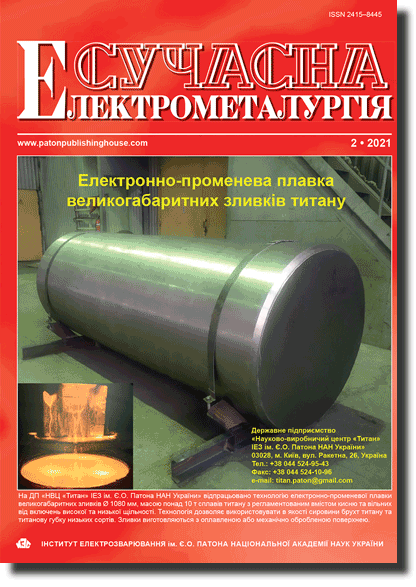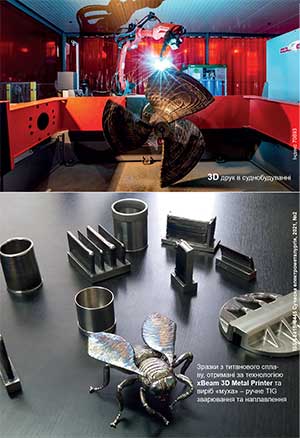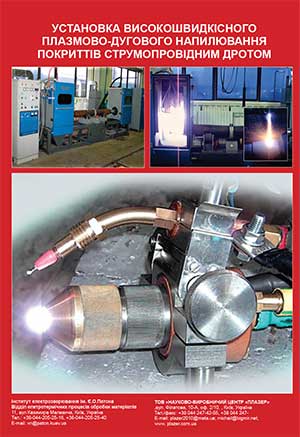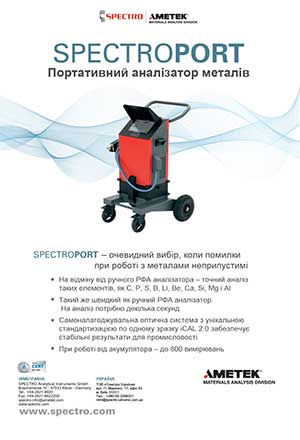| 2021 №02 (02) |
DOI of Article 10.37434/sem2021.02.03 |
2021 №02 (04) |
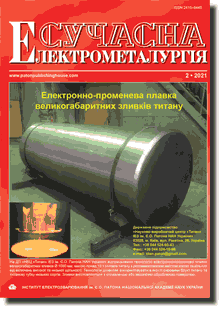
"Suchasna Elektrometallurgiya" (Electrometallurgy Today), 2021, #2, 19-25 pages
Problems and their solution at application of higher power steam-water plasmatrons
S.V. Petrov
Institute of Gas of the NAS of Ukraine 39 Dehtiarivska Str., 03113, Kyiv, Ukraine. E-mail: vizana.sp@gmail.com
Abstract
Implementation of new technologies of multiton plasma chemistry requires development of reliable higher-power longlife plasmatrons. During plasmatron operation, the cathode undergoes the most intensive wear, the anode life being approximately two times longer. Ingenious designs of steam-water transferred-arc plasmatrons were developed with application of two types of cathode assemblies: tungsten (PLR-3P) and copper tubular one (PLR-4P). In the latter the low level of tubular cathode erosion is ensured by distribution of the heat flow from the arc support point to a large area as a result of its fast movement (~ 100 m/s) due to gas-dynamic and magnetic forces that act on the arc radial region. Here, the arc spot scans the electrode working surface, while being between the aerodynamic and magnetic planes. At operation of PLR-4P plasmatron at 300 A current the cathode erosion was 9∙10–7 g/C for air, and for water steam it was 3∙10–7 g/C. More over, when water steam is used, the cathode surface remains clean and erosion level does not depend on operation time, whereas at operation in air the surface is covered by a black film of copper oxide (CuO). It is found that self-extinction of the electric arc can occur in the blind electrode, because of fluctuations of current and voltage and gas-dynamic instability of the vortex flow. In order to avoid self-extinction of the electric arc, 12-phase rectification circuits should be used for supplying power to steam-water plasmatrons of higher power (100…500 kW). Ref. 27, Fig. 6.
Keywords: steam-water plasmatron; tubular cathode; erosion; magnetic vortex stabilization of arc; self-extinguishing of arc
Received 25.03.2021
References
1. Rutberg, Ph.G., Bratsev, A.N., Kuznetsov, V.A. et al. (2011) On efficiency of plasma gasification of wood residues. Biomass Bioenergy, 35(1), 495-504. https://doi.org/10.1016/j.biombioe.2010.09.0102. Petrov, S.V., Katircioğlu, T.Y. (2020) Technological aspects of steam and water plasma. OmniSkriptum Publishing Group.
3. Hrabovsky, M., Hlina, M., Konrad, M. et al. (2013) Steam plasma-assisted gasification of organic waste by reactions with water, CO2 and O2. In: Proc. of 21st Intern. Sym. on Plasma Chemistry ISPC 21, (4-9 August 2013, Cairns Convention Centre, Queensland, Australia).
4. Kaushal, P., Tyagi, R. (2012) Steam assisted biomass gasification: An overview. Can. J. Chem. Eng., 90(4), 1043-1052. https://doi.org/10.1002/cjce.20594
5. Bratsev, A.N., Kuznetsov, V.A., Popov, V.E. et al. (2009) Estimation of perspectivity of steam plasma methane conversion. High Temp. Mater. Processes, 13(2), 241-246. https://doi.org/10.1615/HighTempMatProc.v13.i2.120
6. Narengerile, H. Saito, Watanabe, T. (2010) Decomposition mechanism of fluorinated compounds in water plasmas generated under atmospheric pressure. Plasma Chemistry and Plasma Processing, 6, 17. https://doi.org/10.1007/s11090-010-9259-y
7. Petrov, S.V. (2021) Innovative plasma jet technologies. LAP Lambert Academic Publishing.
8. Tamosiunas, A., Valatkevicius, P., Valincius, V., Levinskas, R. (2016) Biomass conversion to hydrogen-rich synthesis fuels using water steam plasma. Comptes Rendus Chimie, 19(4), 433-440. https://doi.org/10.1016/j.crci.2015.12.002
9. Galvitaa, V., Messerle, V.E., Ustimenko, A.B. (2007) Hydrogen production by coal plasma gasification for fuel cell technology. Int. J. of Hydrogen Energy, 32, 3899-3906. https://doi.org/10.1016/j.ijhydene.2007.05.039
10. Tao, K., Ohta, N., Liu, G. et al. (2010) Plasma enhanced catalytic reforming of biomass tar model compound to syngas. Fuel. Available onlinе. doi:10.1016/j.fuel.2010.05.044. https://doi.org/10.1016/j.fuel.2010.05.044
11. Shiyun, Liu, Danhua, Mei, Li, Wang, Xin, Tu (2017) Steam reforming of toluene as biomass tar model compound in a gliding arc discharge reactor. Chemical Engineering J., 307, 793-802. https://doi.org/10.1016/j.cej.2016.08.005
12. Toumanov, Y.N. (1989) Low-temperature plasma and high-frequency electromagnetic fields in the process of obtaining materials for nuclear power. Moscow, Energoatomizdat [in Russian].
13. Hrabovsky, M. (1998) Water-stabilized plasma generators. Pure and Applied Chemistry, 70(6), 1157-1162. https://doi.org/10.1351/pac199870061157
14. Hrabovsky, M. (2009) Thermal plasma generators with water stabilized arc. The Open Plasma Physics J., 2(1), 99-104. https://doi.org/10.2174/1876534300902020099
15. Mikhajlov, B.I. (2002) Prospects of practical application of arc steam-water plasma. Teplofizika i Aeromekhanika, 9(1), 1-16 [in Russian].
16. Plasma technologies. https://epos-nsk.ru/portfolio-category/ plazmennye-tekhnologii/
17. Model PPT-ST - steam plasma arc torches. https://www.energyxprt. com/products/model-ppt-st-steam-plasma-arc-torches-538911
18. (2016) Steam plasma arc refrigerant cracking system (SPARC-10™). https://streblenergy.com/2016/06/17/steamplasma-arc-refrigerant-cracking-system-sparc-10tm/
19. Krivtsov, V.S., Plankovsky, S.I. (2005) Problems of development of long-life high-current electric arc plasmatrons. Aviats.-Kosmich. Tekhnika i Tekhnologiya, 7, 7-20 [in Russian].
20. MARC-11 Plasma Torch. https://aquasourcetechnologies. com/marc-11-plasma-torch/
21. Anshakov, A.S., Urbakh, E.K., Cherednichenko, V.S. et al. (2012) Development and investigation of arc plasmatrons for heating of air with long service life. Energotekhnologii i Resursosberezhenie, 5, 4-8 [in Russian].
22. Jeanvoine, N. (2009) Plasma - material interaction and electrode degradation in high voltage ignition discharges: Dissertation zur Erlangung des Grades des Doktors der Ingenieurwissenschaften. Saarbrücken, 166.
23. Mikhajlov, B.I. (2008) Autoscanning in plasmatrons with magnetic vortex arc stabilization. Teplofizika i Aeromekhanika, 15(3), 551-553 [in Russian]. https://doi.org/10.1134/S0869864308030189
24. Essiptchouk, A.M., Marotta, A., Sharakhovsky, L.I. (2004) The effect of arc velocity on cold electrode erosion. Phys. Plasmas, 11(3), 1214-1219. https://doi.org/10.1063/1.1647562
25. Benilov, M.S., Cunha, M.D., Hartmann, W. et al. (2013) Space-resolved modeling of stationary spots on copper vacuum arc cathodes and on composite CuCr cathodes with large grains. IEEE Transact. on Plasma Sci., 41(8), 1950-1958. https://doi.org/10.1109/TPS.2013.2263255
26. Rao, L., Munz, R.J. (2008) Effect of cathode microstructure on arc velocity and erosion rate of cold cathodes in magnetically rotated atmospheric pressure arcs. J. of Thermal Spray Technol., 17(4), 574-582. https://doi.org/10.1088/0022-3727/41/16/165201
27. Messerle, B.E., Ustimenko, A.B., Ushanov, B.Zh. et al. (2014) Formation of nanocarbon materials in arc plasmatrons. Vestnik VSGUTU, 2, 13-20 [in Russian].
Advertising in this issue:
The cost of subscription/purchase order journals or individual articles
| Journal/Currency | Annual Set | 1 issue printed |
1 issue |
one article |
| TPWJ/USD | 384 $ | 32 $ | 26 $ | 13 $ |
| TPWJ/EUR | 348 € | 29 € | 24 € | 12 € |
| TPWJ/UAH | 7200 UAH | 600 UAH | 600 UAH | 280 UAH |
| AS/UAH | 1800 UAH | 300 UAH | 300 UAH | 150 UAH |
| AS/USD | 192 $ | 32 $ | 26 $ | 13 $ |
| AS/EUR | 180 € | 30 € | 25 € | 12 € |
| SEM/UAH | 1200 UAH | 300 UAH | 300 UAH | 150 UAH |
| SEM/USD | 128 $ | 32 $ | 26 $ | 13 $ |
| SEM/EUR | 120 € | 30 € | 25 € | 12 € |
| TDNK/UAH | 1200 UAH | 300 UAH | 300 UAH | 150 UAH |
| TDNK/USD | 128 $ | 32 $ | 26 $ | 13 $ |
| TDNK/EUR | 120 € | 30 € | 25 € | 15 € |
AS = «Automatic Welding» - 6 issues per year;
TPWJ = «PATON WELDING JOURNAL» - 12 issues per year;
SEM = «Electrometallurgy Today» - 4 issues per year;
TDNK = «Technical Diagnostics and Non-Destructive Testing» - 4 issues per year.





